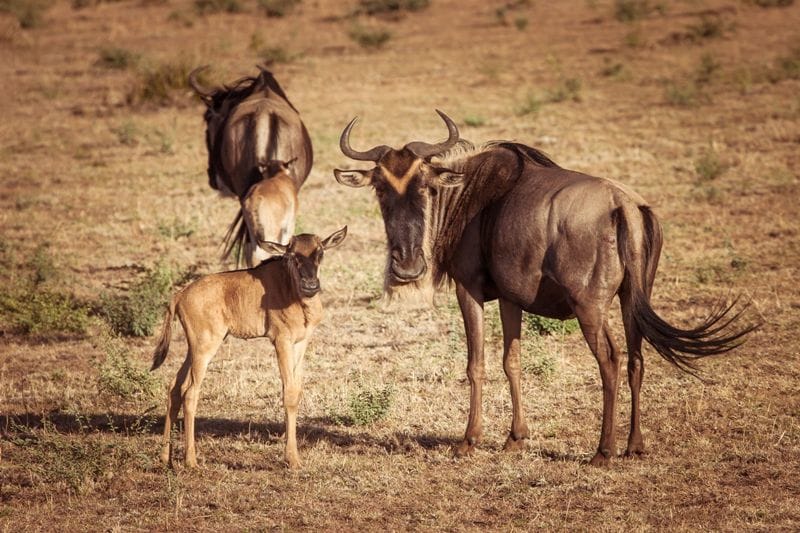Hailed as one of the Seven Natural Wonders of Africa, the Great Wildebeest Migration is the most exhilarating wildlife spectacle in Africa. This annual event sees more than a million wildebeest, accompanied by tens of thousands of zebra, eland and Thompson’s gazelle, traverse thousands of kilometers across Eastern Africa.
Of course, such a large congregation of prey lumbering across endless plains and treacherous rivers naturally means there are also opportunistic predators like lions, leopards, cheetahs, and crocodiles following their trail. For many travelers, witnessing this amazing scene can be a life-changing experience.

Interesting Facts about this Spectacular Event
- It is the world’s largest concentrated migration of wildlife
- The annual Great Migration is triggered by dry season, prompting these animals to embark on the journey in search of food and water. The receding rainfall means they must look elsewhere, not just to feed, but also to birth their young, a new generation of wildebeests.
- Many observers have noted that the wildebeests and zebras are natural allies, helping one another on this journey by feeding on the same plant but different parts of it, which enables them to graze harmoniously. In addition, the wildebeests help sniff out water from the ground, while zebras help navigate the wildebeests and keep them on course during their year-long voyage.
- The Great Migration occurs only in two East African countries, Kenya and Tanzania. Most of the migration takes place in Tanzania’s Serengeti and from there they traverse into the Masai Mara reserve in the neighboring Kenya. To experience this amazing wildlife spectacle, you need to know where they migrate depending on the time of year you decide to visit.
- The ecosystem in the Serengeti is believed to be one of the oldest in the world with the climate and vegetation remaining the same for thousands of years.
- According to researchers, wildebeests operate on swarm intelligence, a term used to describe how they systematically explore and overcome the obstacle as one, kind of like the clustering behavior of ants.
- An estimated 8000 wildebeest are born every day for about 3 weeks during the birthing season, which usually starts in mid-February. Being born during the journey, the calves must learn to walk almost as soon as they are born.
- Throughout the year, travelers can expect to see the drama unfold with wildebeest being dragged into raging rivers by the jaws of crocodiles, newborn calves taking their first steps, and breathtaking scenes as hundreds of thousands of animals graze on East Africa’s spellbinding savannah.

What Makes the Event so Popular?
The uniqueness of the Great Wildebeest Migration makes it one of the must-see events for any African safari traveler. Whether from the back of a 4×4 vehicle, on foot, or from a bird’s eye view in a hot air balloon, seeing the multitude of herds on the move is an experience not easily forgotten. It doesn’t just bring you closer to nature, but also provides an intimate insight into the circle of life on a scale that does not occur anywhere else on the planet.
That’s what makes it one of the most popular wildlife events in Africa, especially when compared to other wondrous sights like the big five and endangered species, such as the black rhino and the African wild dog. In fact, a case can be made for it to be recognized as the greatest wildlife event in the world.
The Great Migration and the Ecosystem
This wondrous event is tangible proof of the magnificence of nature — year after year, tirelessly playing host to herbivores of such magnitude. But beyond being an amazing spectacle, the wildebeests have become an integral species to the ecosystem. Their sheer number means tree seedlings never become established, which in turn, prevents forests from encroaching on the endless plains of the savannah.
The animals’ dung is also a good source of fertilizer for the grass species, while the wildebeests and zebras and gazelles themselves provide food for the predators. As such, without the annual Great Migration, the scenic grasslands and so many of the creatures we associate with Africa face extinction.

Actual and Possible Threats
In recent times, there has been a great concern about the declining wildebeests in East Africa and by extension, the Great Migration. Human development and agricultural activity have repeatedly decimated the Mau Forest, the largest forest in Kenya and the source of the magnificent Mara River, which provides much needed water to these animals during their voyage.
In addition, like everywhere else in the world, climate change threatens the existence of not just these lumbering beasts, but also the environment around them. Droughts have become more frequent and severe over the years, diminishing the wildebeest population and altering the pattern of their migration as they look to other locations for food and water.
Now more than ever, travelers must practice sustainable tourism. We must play our part in conserving our natural environment, consuming less, and ultimately, being more conscious about how our travel choices affect the host environment. Choosing accommodation options that are eco-friendly, opt for locally prepared foods or eco-friendly lunch boxes that do not require significant packaging and plastic. Of course, governments also have a role to play by taking decisive measures to encourage afforestation and other methods of preventing drought to not let the Great Migration be at stake.
